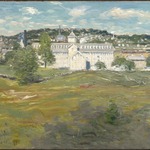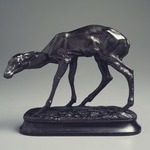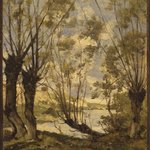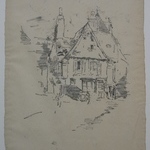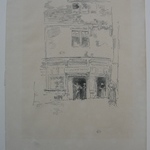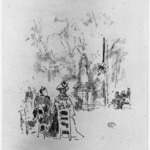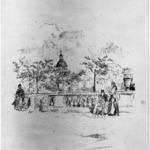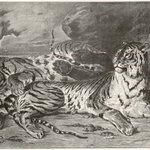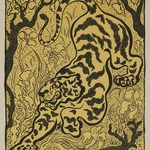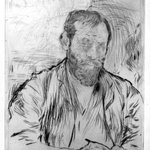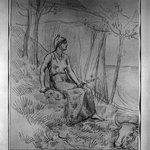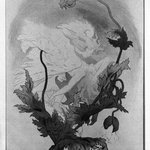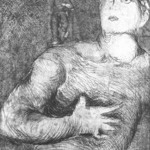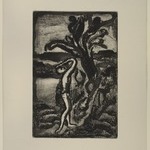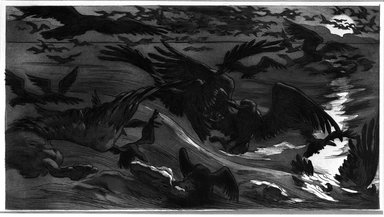
Oiseaux de Proie
Victor-Emile Prouvé
European Art
Diego Rivera, like many other artists working after the Mexican Revolution (1910–20), engaged with the nationalist political ideology known as indigenismo, which emphasized Mexico’s Indigenous roots in an attempt to unify the state and foster a cohesive and hybrid national identity.
Copalli takes its name from the Nahuatl (an Indigenous language) and Spanish words for copal, the aromatic tree resin employed for centuries in Mesoamerica as incense. Considered the “blood” of trees, copal was also used as a binder for pigments in ancient mural painting. Beginning in the 1920s, the Mexican government embraced muralism as a tool to widely convey social and political themes. By highlighting muralism’s Indigenous origins through the image of two copal trees, Rivera connected this art form to a specifically “Mexican” artistic tradition.
Copalli takes its name from the Nahuatl (an Indigenous language) and Spanish words for copal, the aromatic tree resin employed for centuries in Mesoamerica as incense. Considered the “blood” of trees, copal was also used as a binder for pigments in ancient mural painting. Beginning in the 1920s, the Mexican government embraced muralism as a tool to widely convey social and political themes. By highlighting muralism’s Indigenous origins through the image of two copal trees, Rivera connected this art form to a specifically “Mexican” artistic tradition.
MEDIUM
Etching on Arches paper
DATES
1893
DIMENSIONS
9 5/16 x 16 9/16 in. (23.7 x 42.1 cm) (show scale)



MARKINGS
Watermarks: "Arches"
SIGNATURE
Signed, "V. Prouve" lower right
INSCRIPTIONS
No. 57 in pencil, lower right
Embossed stamp, lower right, "L'estampe originale"
COLLECTIONS
European Art
ACCESSION NUMBER
38.360
CREDIT LINE
Charles Stewart Smith Memorial Fund
MUSEUM LOCATION
This item is not on view
CAPTION
Victor-Emile Prouvé (French, 1858–1943). Oiseaux de Proie, 1893. Etching on Arches paper, 9 5/16 x 16 9/16 in. (23.7 x 42.1 cm). Brooklyn Museum, Charles Stewart Smith Memorial Fund, 38.360 (Photo: Brooklyn Museum, 38.360_bw.jpg)
IMAGE
overall, 38.360_bw.jpg. Brooklyn Museum photograph
"CUR" at the beginning of an image file name means that the image was created by a curatorial staff member. These study images may be digital point-and-shoot photographs, when we don\'t yet have high-quality studio photography, or they may be scans of older negatives, slides, or photographic prints, providing historical documentation of the object.
RIGHTS STATEMENT
No known copyright restrictions
This work may be in the public domain in the United States. Works created by United States and non-United States nationals published prior to 1923 are in the public domain, subject to the terms of any applicable treaty or agreement.
You may download and use Brooklyn Museum images of this work. Please include caption information from this page and credit the Brooklyn Museum. If you need a high resolution file, please fill out our online application form (charges apply).
The Museum does not warrant that the use of this work will not infringe on the rights of third parties, such as artists or artists' heirs holding the rights to the work. It is your responsibility to determine and satisfy copyright or other use restrictions before copying, transmitting, or making other use of protected items beyond that allowed by "fair use," as such term is understood under the United States Copyright Act.
The Brooklyn Museum makes no representations or warranties with respect to the application or terms of any international agreement governing copyright protection in the United States for works created by foreign nationals.
For further information about copyright, we recommend resources at the United States Library of Congress, Cornell University, Copyright and Cultural Institutions: Guidelines for U.S. Libraries, Archives, and Museums, and Copyright Watch.
For more information about the Museum's rights project, including how rights types are assigned, please see our blog posts on copyright.
If you have any information regarding this work and rights to it, please contact copyright@brooklynmuseum.org.
RECORD COMPLETENESS
Not every record you will find here is complete. More information is available for some works than for others, and some entries have been updated more recently. Records are frequently reviewed and revised, and we welcome any additional information you might have.
